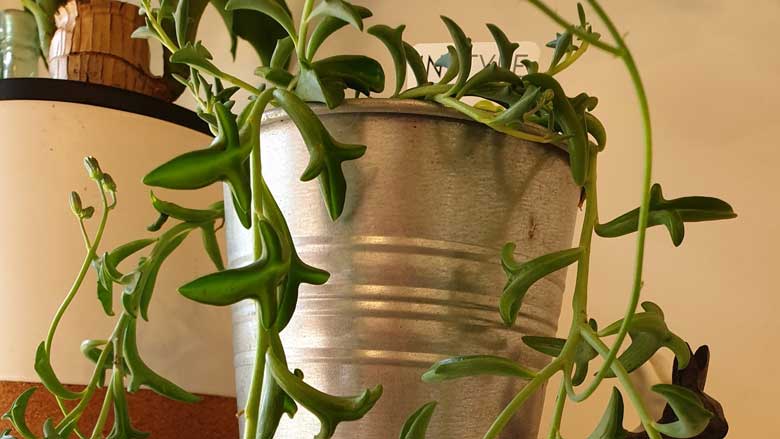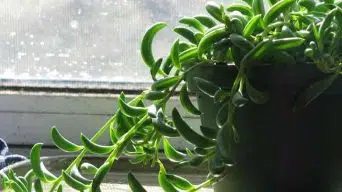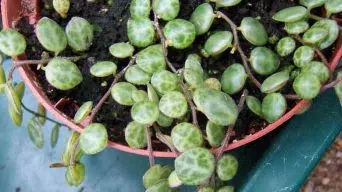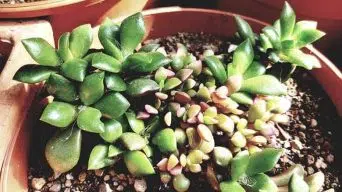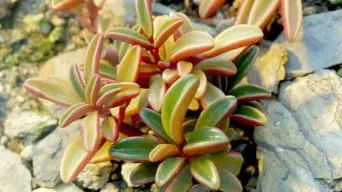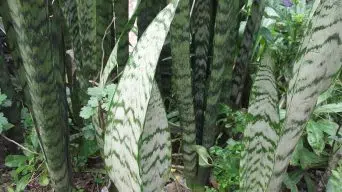Growing succulents is very popular nowadays. They are easy to grow, and they look great all year long because of their interesting shapes, colors, and textures
One of the most exciting and eye-catching succulents you can grow is String of Dolphins (Curio × peregrinus).
String of Dolphins care is not complex, but there are a few things to consider when it comes to this type of succulents.
Let’s take a look at how to care for these beautiful plants.
Overview
String of Dolphins, also known as Curio × peregrinus or Senecio peregrinus, is a hybrid plant between String of pearls (Curio rowleyanus) and Candle plant (Curio articulates) in the family Asteraceae
The leaves of this trailing succulent resemble little dolphins leaping out of the water, and it can grow up to 6 inches (15 cm) tall.
The flowers are tiny, white, and tightly packed into puffballs and appear in the fall. Each blossom is ringed with a halo of red to yellow filaments.
In addition to being known as String of Dolphins, the Curio × peregrinus is also called:
- Dolphin necklace
- Flying dolphins
- Dolphin plant
- Senecio peregrinus
- Senecio hippogriff
How To Care for Curio × Peregrinus (String of Dolphins)
String of Dolphins care isn’t complicated, but it requires particular conditions to thrive.
Below you’ll find the essential information you need to know about caring for String of Dolphins (Curio × Peregrinus).
Sun Exposure & Light Requirements
The String of Dolphins succulent plant has moderate sunlight requirements with the minimum recommended sun exposure not less than 4-5 hours per day.
The ideal place to place your String of Dolphins is in front of an east-facing window that receives at least 4 hours of morning sunlight-that would be just enough light for the String of Dolphins succulent plant to thrive.
The String of Dolphin succulent plant also grows well under a west-facing window – although it will get slightly more sun exposure.
The west-facing window is less desirable than an east-facing window because of the shortened days in fall and winter.
When outdoors, the String of Dolphins succulent plant thrives best in a location with indirect sunlight (partial shade)-such as under a covered patio or on an east-facing porch.
The String of Dolphins succulent plant enjoys lots of morning sun, but it needs protection from direct afternoon/evening sun to avoid leaf burn.
It can survive without too much light (in which case it will be more challenging to propagate), but it won’t thrive.
Watering Requirements
Water your String of Dolphins plant when the soil has dried up. Ensure that the plant is not overwatered, as fungal rot can occur because of this.
Place a finger into the soil; if it is still wet, do not water it yet. If dry, leave the plant to absorb moisture and water thoroughly.
Watering once every one to two weeks should be sufficient during the spring and summer months if you are in a warmer climate or season.
The winter requires barely any watering because the soil naturally retains less moisture due to colder temperatures.
Soil Requirements
The String of Dolphins succulent likes sandy soil or cacti soil that is very easy to drain.
A cactus soil mix would be perfect for this plant.
You can use potting or garden soil to make your own mix with a ratio of 1:1:1 (soil, sand, perlite) for good drainage.
If you are planting in a pot, make sure it has plenty of drainage holes since the plant won’t grow well if the roots are constantly moist.
Temperature and Humidity
String of Dolphins likes temperatures between 70°F and 80°F (20°C and 27°C). They are best grown indoors.
When temperatures rise above 90°F (32°C), it’s a good idea to put your String of Dolphins in a shady location, so the leaves don’t desiccate.
String of Dolphins do not like high humidity, so you must provide well-ventilated conditions for them to grow in.
They need a humidity level that is around 40%.
Fertilizing
String of Dolphins succulent plants don’t need additional fertilizer.
If you wish to fertilize your plant, use a balanced liquid fertilizer diluted to half-strength, and apply it once every other month during the growing season (spring/summer).
Don’t let the fertilizer touch the stem; only apply it to the soil.
Avoid fertilizing your String of Dolphins plant during the fall and winter.
Potting and Repotting
String of Dolphins is a trailing succulent. Related to the Jade Plant, String of Dolphins can be planted in small containers or hanging baskets, which will allow the long stems to cascade toward the ground.
They can also be allowed to climb up a trellis. However it’s grown, this succulent plant should always have its stems buried deep enough that they can support the plant’s weight.
String of Dolphins can be used for ground covering between other succulents or flowering plants. In that situation, the trailing stems can spread across the ground before they are rooted.
When planting String of Dolphins in hanging baskets or small containers, ensure that the container has adequate drainage.
String of Dolphins will not grow well in wet soil, and it may rot if allowed to stay soggy for long periods.
When planting the succulent stem cuttings directly into the ground, dig a small hole deep enough to support the plant’s roots.
Burying the stem between two and four inches under the soil depends on how high you want the plant to grow.
String of Dolphins should be repotted in the early spring.
If you are planting the succulent in a container, look for one that is at least two inches larger than the previous pot it was growing in because these plants grow fast and will quickly outgrow their homes.
Pruning
Pruning is an essential aspect of caring for String of Dolphins.
It is necessary to keep the size of the plant under control, especially with an older String of Dolphins that has reached its maximum potential height.
Pruning will be required if you want to maintain a compact “potted plant” look.
However, String of Dolphins can also be pruned to encourage re-growth and propagation.
If you are looking to grow another String of Dolphins or if you want to start propagation, then pruning is necessary.
Pruning String of Dolphins requires the removal of older stems to allow new growth to appear further up on the stem.
To do this, remove the dried out (or dead) stem with a pair of cuticle scissors or any other type of small, sharp scissor.
Make sure to clean and sterilize your tools between snips to prevent infection and disease.
When pruning, make sure you do not remove the leaves from the removed part of the stem.
You can pull away the leaves from the stem once you have finished snipping.
Using a pair of loppers or secateurs may be necessary to remove their bulk with larger stems.
In this case, remember not to cut the stem too close to the base, as this could cause damage and loss of water storage.
Pests and Diseases
The String of Dolphins succulent is not prone to pests.
Mealybugs or spider mites can sometimes infest them, but these are easily eradicated using alcohol or soapy water mixed with neem oil.
Aphids can sometimes appear on the String of Dolphin plant, which is often easily taken care of by simply spraying them with water or using neem oil mixed with water.
Don’t overwater them, though, as they are susceptible to root rot. If the leaves are pulling away from the stem, it could be because they are water-stressed.
The String of Dolphins succulent plant itself is pretty hard to distort, but the stem can get soft and mushy, which can be a sign of root rot or simply rotting from being left in water too long.
When this happens, cutting the stem and allowing the plant to dry is best. Then it can be replanted using a new pot with fresh soil.
Also, the String of Dolphins can be affected by viruses, often seen as yellow blotches all across the succulent’s stem.
To prevent this, it’s best not to overwater and use a very small amount of liquid fertilizer or place them in direct sunlight for most of the day.
The String of Dolphins succulent plant is generally pest resistant if the owner uses common sense.
If there are indicators of pests, it’s best to take immediate action to prevent any further damage.
How to Care for String of Dolphins (Curio × Peregrinus) in Winter
String of Dolphins succulents are cold-sensitive.
If you have a String of Dolphins succulent, it is essential to remember that they should not be exposed to temperatures below 50°F./10°C.
In addition, no matter the season, you should never expose your String of Dolphins plant to freezing temperatures as this can quickly kill them.
During winter, if you live in a colder climate or an environment where temperatures can be expected to drop below 50°F./10°C., it is best to bring your String of Dolphins inside your house or into a greenhouse garage, or some other structure that is climate-controlled.
In addition to protecting from temperatures below 50°F./10°C., it is also important to protect from cold drafts. Wind can easily desiccate String of Dolphins succulents, and this can cause damage to the plant.
To protect String of Dolphins succulents from temperature changes, it is ideal to place them on a table or shelf to protect them from the ground and any drafts that may come in contact with them.
If possible, avoid placing them under windows for this reason as well.
If you are bringing String of Dolphins succulents indoors for the winter, it is essential to acclimate them to their new environment before exposing them to cold temperatures.
To do this, place your plant in the area where you plan on keeping it for a day or two and allow it to adjust gradually.
You also want to make sure that you water your String of Dolphins succulents less frequently during winter.
Because cold weather tends to dry things out, String of Dolphins plants need less water.
Watering once every two weeks or so should suffice in most cases unless the soil is completely dried up.
Providing the proper amount of bright light for your String of Dolphins succulent during winter is also important.
String of Dolphins require a great deal of sunlight and, as such, it is best to keep them in an area that receives plenty of it.
During winter, when the days are shorter, you may need to supplement with artificial lighting if your String of Dolphins is not getting enough sunlight.
In winter, simple changes to care for your String of Dolphins can help protect them from being exposed to freezing or cold temperatures, drafts, and low light conditions.
By making these changes, you can help ensure that your String of Dolphins is healthy and thriving throughout winter.
How To Propagate String of Dolphins (Curio × Peregrinus)
String of Dolphins propagation can be done by stem cuttings or leaf cuttings.
A cutting can be taken from almost any plant section, but it is best to take them from the growing tip. This will ensure that you get more of the characteristics of the mother plant in your new String of Dolphins.
Stem Cuttings
To propagate String of Dolphins by stem cuttings:
- Take cuttings from the top of the String of Dolphins stem. Ensure that at least two nodes (the place where the leaves join) are on your cutting and that there is some stem under it.
- Let the cut callous for a few days. Callous is the process in which the exposed plant tissue forms a white, calloused layer over the cut.
- Plant your cutting in a succulent potting mix with 1/3 perlite added.
- Water your String of Dolphins cutting sparingly, only enough to keep the soil from drying out until you see new growth.
- Your String of Dolphins cutting should start showing new growth about two weeks after taking the cutting.
- Once your String of Dolphins stem cutting has rooted, transplant it into a small pot to grow.
Leaf Cuttings
To propagate String of Dolphins by leaf cuttings:
- Pull off a leaf from the end of a stem.
- Make sure to get all the flesh off the bottom part of the leaf and free from any flesh still attached to the stem.
- Let the leaves dry out for a few days to form a callus.
- Place the leaves on top of moist leaf-cutting soil or regular succulent soil.
- It is best to put the container inside a clear plastic bag to hold in moisture, but make sure that there are still holes for air.
- Keep the soil moist and place the whole thing under bright indirect light (but not direct sun).
- Keep an eye on the leaves to ensure they are not rotting. Rotting usually looks like dark patches or spots, which a bad smell can recognize.
- When roots start forming, transplant them into new soil and transfer them into bigger containers as needed.
Final Thoughts
Growing succulents is an easy and fun hobby. Many different species of succulents come in beautiful colors and interesting leaf shapes.
Hanging succulents like these String of Dolphins plants are great for people with pets or children as they are impossible to tip over and break.
You can hang them from your porch or backyard fence, and because this particular species (Curio × Peregrinus) has long and narrow leaves, it doesn’t take up very much space.
The best part is that if you forget to water them one day, they’ll probably not die (but if you can keep them watered, that’s even better!)
Some people like growing String of Dolphins indoors. They are great for tables, shelves, or any other space because they take up very little room and don’t need direct sunlight.
All in all, hanging succulents like these String of Dolphins make for beautiful and functional home decorations. They don’t take up much space, giving any room a nice green touch.

